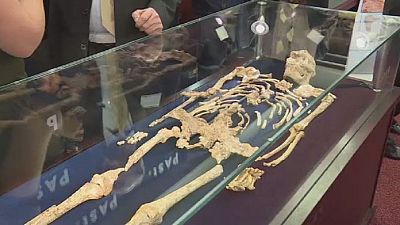South Africa
South African researchers on Wednesday unveiled the almost complete skeleton of the famous Australopithecus Little Foot in Johannesburg.
The 3.67 million years old Little Foot’s reconstruction should shed new light on the lives of these very distant ancestors,said British paleontologist Ron Clarke.
Little Foot was discovered in small pieces from 1994 by the British paleontologist Ron Clarke in a cave of Sterkfontein, near Johannesburg.
It took him over twenty years to carefully extract all the pieces and present the complete fossil with his colleagues at the University of the Witwatersrand.
“It took us a lot of time because we chose to exhume the fossil in the cave itself,” Clarke told AFP on Wednesday. “The bones were extremely fragile,” he said, adding that he acted “like a surgeon”.
At 90%, Little Foot is today the most complete skeleton of a humanoid more than a million and half years old available to researchers.
The specimen is still far from having delivered all its secrets but it already allows, according to Ron Clarke, to question certain ideas on these distant cousins of the modern Homo sapiens.
“What Little Foot shows us is that the image represented in our books of our ancestors walking on all fours and then rising gradually is totally false,” he said.
While studying the skeleton, the paleontologist discovered that his hands were very close to those of humans and his legs longer than his arms.
“Our ancestors were standing up when they lived in the trees and when they came down they were standing up,” said Ron Clarke, “Little Foot never went through the monkey stage, with long arms and long hands “.
The observation of his teeth also allowed him to say that Little Foot was a woman “about 30 years old”.
According to Dr. Clarke, the skeleton study should feed some twenty scientific articles in the coming years.














Go to video
Semenya ruling shakes foundations of gender rules in sport
01:53
SMES under pressure as business confidence hits four-year low in South Africa
02:02
Could AI help fight mosquito-borne diseases?
Go to video
Former South African deputy president David Mabuza dies at 64
02:20
Ancient DNA reveals genetic link between early Egypt and Mesopotamia
00:56
South Africa: At least 101 dead in Eastern Cape floods as rescue efforts continue